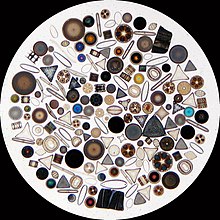Diatomaceae
| Diatoms | |
|---|---|
 |
|
| Marine diatoms | |
| Scientific classification | |
| Domain: | Eukaryota |
| (unranked): | SAR |
| Superphylum: | Heterokonta |
| Phylum: | Ochrophyta |
| Class: |
Bacillariophyceae Dangeard, 1933 |
| Synonyms | |
|
|
Diatoms are a major group of algae, and are among the most common types of phytoplankton. Diatoms are unicellular, although they can form colonies in the shape of filaments or ribbons (e.g. Fragilaria), fans (e.g. Meridion), zigzags (e.g. Tabellaria), or stars (e.g. Asterionella). The first diatom formally described in scientific literature, the colonial Bacillaria paradoxa, was found in 1783 by Danish naturalist Otto Friedrich Müller. Diatoms are producers within the food chain. A unique feature of diatom cells is that they are enclosed within a cell wall made of silica (hydrated silicon dioxide) called a frustule. These frustules show a wide diversity in form, but are usually almost bilaterally symmetrical, hence the group name. The symmetry is not perfect since one of the valves is slightly larger than the other, allowing one valve to fit inside the edge of the other. Fossil evidence suggests that they originated during, or before, the early Jurassic period. Only male gametes of centric diatoms are capable of movement by means of flagella. Diatom communities are a popular tool for monitoring environmental conditions, past and present, and are commonly used in studies of water quality.
More than 200 genera of living diatoms are known, with an estimated 100,000 extant species. Diatoms are a widespread group and can be found in the oceans, in fresh water, in soils, and on damp surfaces. They are one of the dominant components of phytoplankton in nutrient-rich coastal waters and during oceanic spring blooms since they can divide more rapidly than other groups of phytoplankton. Most live pelagically in open water, although some live as surface films at the water-sediment interface (benthic), or even under damp atmospheric conditions. They are especially important in oceans, where they contribute an estimated 45% of the total oceanic primary production of organic material. Spatial distribution of marine phytoplankton species is restricted both horizontally and vertically. Though most are microscopic, some species of diatoms can reach up to 2 mm in length.
...
Wikipedia
